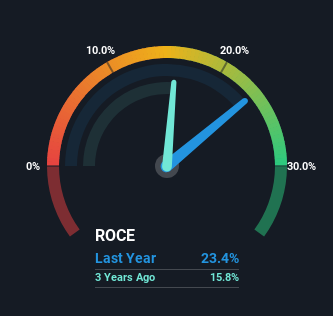There are a few key trends to look for if we want to identify the next multi-bagger. Amongst other things, we'll want to see two things; firstly, a growing return on capital employed (ROCE) and secondly, an expansion in the company's amount of capital employed. If you see this, it typically means it's a company with a great business model and plenty of profitable reinvestment opportunities. Looking at Technogym (BIT:TGYM), it does have a high ROCE right now, but lets see how returns are trending.
Our free stock report includes 1 warning sign investors should be aware of before investing in Technogym. Read for free now.Return On Capital Employed (ROCE): What Is It?
For those who don't know, ROCE is a measure of a company's yearly pre-tax profit (its return), relative to the capital employed in the business. The formula for this calculation on Technogym is:
Return on Capital Employed = Earnings Before Interest and Tax (EBIT) ÷ (Total Assets - Current Liabilities)
0.23 = €123m ÷ (€904m - €379m) (Based on the trailing twelve months to December 2024).
So, Technogym has an ROCE of 23%. While that is an outstanding return, the rest of the Leisure industry generates similar returns, on average.
Check out our latest analysis for Technogym

In the above chart we have measured Technogym's prior ROCE against its prior performance, but the future is arguably more important. If you'd like, you can check out the forecasts from the analysts covering Technogym for free.
How Are Returns Trending?
When we looked at the ROCE trend at Technogym, we didn't gain much confidence. While it's comforting that the ROCE is high, five years ago it was 30%. Although, given both revenue and the amount of assets employed in the business have increased, it could suggest the company is investing in growth, and the extra capital has led to a short-term reduction in ROCE. And if the increased capital generates additional returns, the business, and thus shareholders, will benefit in the long run.
On a side note, Technogym's current liabilities are still rather high at 42% of total assets. This effectively means that suppliers (or short-term creditors) are funding a large portion of the business, so just be aware that this can introduce some elements of risk. While it's not necessarily a bad thing, it can be beneficial if this ratio is lower.
In Conclusion...
In summary, despite lower returns in the short term, we're encouraged to see that Technogym is reinvesting for growth and has higher sales as a result. Furthermore the stock has climbed 85% over the last five years, it would appear that investors are upbeat about the future. So while the underlying trends could already be accounted for by investors, we still think this stock is worth looking into further.
On a final note, we've found 1 warning sign for Technogym that we think you should be aware of.
Technogym is not the only stock earning high returns. If you'd like to see more, check out our free list of companies earning high returns on equity with solid fundamentals.
Valuation is complex, but we're here to simplify it.
Discover if Technogym might be undervalued or overvalued with our detailed analysis, featuring fair value estimates, potential risks, dividends, insider trades, and its financial condition.
Access Free AnalysisHave feedback on this article? Concerned about the content? Get in touch with us directly. Alternatively, email editorial-team (at) simplywallst.com.
This article by Simply Wall St is general in nature. We provide commentary based on historical data and analyst forecasts only using an unbiased methodology and our articles are not intended to be financial advice. It does not constitute a recommendation to buy or sell any stock, and does not take account of your objectives, or your financial situation. We aim to bring you long-term focused analysis driven by fundamental data. Note that our analysis may not factor in the latest price-sensitive company announcements or qualitative material. Simply Wall St has no position in any stocks mentioned.
About BIT:TGYM
Technogym
A wellness company, designs, manufactures, and sells fitness equipment in Italy, Rest of Europe, the United States, Asia-Pacific, and the Middle East.
Outstanding track record with flawless balance sheet.
Similar Companies
Market Insights
Community Narratives



